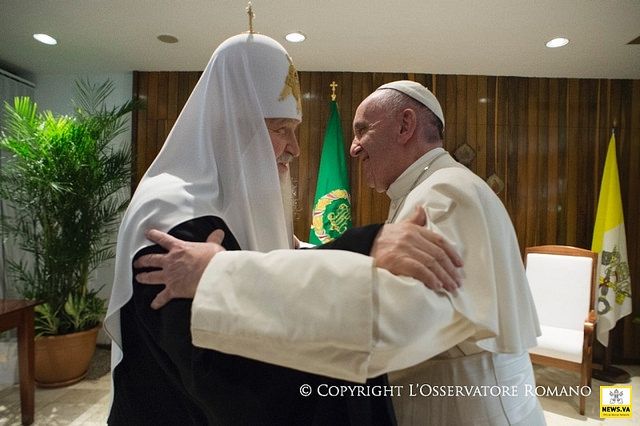[dt_button link=»http://d165vjqq8ey7jy.cloudfront.net/mp3/33033/se-8095s.mp3″ target_blank=»true» button_alignment=»default» animation=»fadeIn» size=»small» style=»default» bg_color_style=»custom» bg_color=»#333333″ bg_hover_color_style=»custom» bg_hover_color=»#444444″ text_color_style=»custom» text_color=»#ffffff» text_hover_color_style=»custom» text_hover_color=»#dddddd» icon=»fa fa-cloud-download» icon_align=»left»]Скачать[/dt_button]
[dt_divider style=»thin» /]
Transcript:
Voice 1
Welcome to Spotlight. I’m Liz Waid.
Voice 2
And I’m Colin Lowther. Spotlight uses a special English method of broadcasting. It is easier for people to understand, no matter where in the world they live.
Voice 1
It is a beautiful Saturday in July in Turkey. In the famous Hagia Sophia cathedral, people are preparing to pray. Just before the prayers are supposed to begin, a man walks in. He places a piece of paper in the middle of the room. The paper states that the religious leader of the city is excommunicated — he is no longer part of the religion. This act will finally break the religion into two parts.
Voice 2
So when did this event happen? Of course, this situation could easily happen today. It could happen in many parts of the world in many different religions. But it happened 1,000 years ago — separating the Christian church into two parts.
Voice 1
When you are not part of a particular religion, it is difficult to see the differences within that religion. But when you are part of a religion, you know there are different groups within it. In Judaism there are Orthodox and Reformed groups. In Islam there is a divide between Shia and Sunni. Today, in Christianity, there are Catholics and Protestants. But 500 years before those groups, there was this split between Eastern and Western churches. In today’s Spotlight we look at this 1,000-year-old fight. We look at how the two leaders of these different parts decided to sit down and listen to each other.
Voice 2
After the separation of the Christian church, the two parts were called the Western Church and the Eastern Church. The Western church was based in Rome. Today, we call it the Catholic Church. And it is led by a Pope. The Eastern Church was spread across Greece, Eastern Europe, and Russia. Today, it is led by a group of men called Patriarchs.
Voice 1
After the year 1054, leadership from each side began to excommunicate people on the other side. That is, they said some people could not attend their church. Each side said that the other side were not real Christians. This created a wider and wider divide between the two groups. But, as church historian Justo L. Gonzalez explained to NPR,
Voice 3
«It is a matter of each church being very deeply locked into in its own ideas. They had difficulty understanding each other”
Voice 2
The reason for the split was complex. There had been disagreements for a long time. For example, they disagreed about what the Bible meant and how to worship. They disagreed about whether the leaders of the church could get married and have families.
Voice 1
But mostly they disagreed about who was in control of the church. Jesus had twelve close friends, called disciples. The Western Church followed the example of the disciple Peter. Peter was a leader among the disciples. The Western Church had one leader — the Pope. But the Eastern Church argued that all of the disciples were equally important. So, the Eastern Church had a few equally important leaders, the Patriarchs.
Voice 2
And for the 1,000 years the churches continued to disagree about many things.
Voice 1
But things began to change in 2009. That is the year Patriarch Kirill became the leader of the Eastern Orthodox Church of Moscow. This is the biggest group in of the Eastern Orthodox Church. Kirill is a complex figure. Some people do not like him. They claim he is too close to the government. But another reason is that he is willing to work with the Catholic Church.
Voice 2
Then, in 2013 Pope Francis became Pope of the Catholic Church. He does things differently than other popes. He wears simple, white clothing. He lives in a simple home. He is a practical leader. He tries to DO something good — not just talk about it. He is also willing to work with people outside the church.
Voice 1
So in 2013 there were two leaders who were willing to talk. But this was not enough. It was still very difficult to have a meeting. They decided on a reason to get together. This reason was the persecution of Christians living in Syria and Iraq.
Voice 2
It still took two years of secret planning for the meeting to take place. One of the biggest issues was where they should meet. It could not be a place that seemed to belong to one side or the other. They decided on Havana, Cuba.
Voice 1
And so, in February of 2015 the two leaders finally met together. They sat and talked. People took many pictures. The goal of the meeting was not to join the parts of the church together again. Instead, it was simply to talk to and listen to each other. It was important as a sign that the two parts of the church were willing to work together.
Voice 2
After the meeting, the two leaders signed a joint declaration—a document of things they agreed on. The document said that Pope Francis and Patriarch Kirill were not competing against each other. Instead, they were brothers. And the most important thing they agreed on was the struggle of Christians being persecuted and killed in Iraq and Syria. The statement read:
Voice 4
“We call on the international community to act immediately to prevent people from forcing Christians to leave the Middle East. In raising our voice to defend Christians, we also wish to express our love for suffering people of other religious traditions. They have also become victims of civil war, unrest and terrorist violence. Thousands of victims have been killed in Syria and Iraq. Many other millions are without a home or jobs. We urge the international community to seek an end to the violence and terrorism. At the same time, this community must give humanitarian aid to the suffering populations and to the many refugees seeking safety in surrounding countries.”
Voice 1
One meeting may not change a lot. But this does not mean that talking is unimportant. People are fighting all over the world. It is difficult to forget the past. Forgiveness and cooperation with a person you disagree with takes courage.
Voice 2
But if two leaders of the Christian church can work to overcome a 1,000 year fight, maybe there is hope for the rest of the world.
Voice 1
What about you? Are there fights that you cannot let go of? Tell us what you think. You can leave a comment on our website. Or email us at radio@radioenglish.net. You can also comment on Facebook at Facebook.com/spotlightradio.
Voice 2
The writer of this program was Adam Navis. The producer was Michio Ozaki. The voices you heard were from the United States and the United Kingdom. All quotes were adapted for this program and voiced by Spotlight. You can listen to this program again, and read it, on the internet at www.radioenglish.net. This program is called, ‘Ending a 1,000 Year Fight’.
Voice 1
We hope you can join us again for the next Spotlight program. Goodbye.




